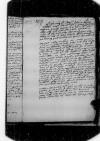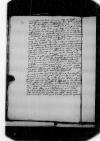Magnifice Domine tamquam frater carissime.
Salutem et felicitatem.
⌊⌋ copiose ⌊⌋ Dominationis Vestrae 21(!) Martii ⌊Barii⌋ datis, duodecima Augusti praeteriti. Ab eo tempore a Dominatione Vestra nullas accepi, unde quod illi interea rescriberem, non habui. Ad praesens tamen mihi temperare non potui, quin saltem Dominationem Vestram ad solitum scribendi officium revocarem, quo utrimque, quid in rebus nostris agatur, scire possemus.
Misi 1526-10-06⌊sexta Octobris novissimi1526-10-06⌋ litteras cambii 300 duc(atorum), quos ⌊hic⌋ a ⌊Welzeris⌋ accepi, quibus prope finem Decembris futuri me sustinebo, ab istis 300, quos 1526-08-12⌊12 Augusti1526-08-12⌋ accepi, nuntium proprium ad ⌊reginalem maiestatem⌋ hic cum provisionibus obtentis expedivi, effecique tantum magna cura et labore, quod tandem reginali maiestati castellanum ⌊castro Barensi⌋ praeficere lic superinscribed in place of crossed-out b⌈bcc superinscribed in place of crossed-out b⌉ebit, qui ⌊caesari⌋ aut viceregi gratus sit, et qui iurare debebit id, quod in remotione sequestri expressum est, et quod castrum hoc in his bellorum turbinibus in manus hostium caesareae maiestatis non perveniat, quemadmodum ex istis provisionibus, quas iam duplicatas ad reginalem maiestatem transmisi, latius cognoscet. Quid in his Π encrypted ⌈ΠΠ encrypted ⌉ faciet cognoscemus experiemur, et cumprimis oro, Dominatio Vestra ad me perscribat. Quod si sic se exhibebit, ut mihi est pollicitus, brevi hinc ex hoc e ms. a(!)
⌈ee ms. a(!)
⌉rgastulo exire licebit, quod summopere <desidero>; sed id citra voluntatem ⌊reginalis maiestatis⌋, quae mihi novissimis iterum iniunxit, ut opperiar hic, donec me expresse dixerit revocandum, fieri non potest. Ferendum est igitur, ⌊⌋.
Scripsit mihi paulo ante ⌊reginalis maiestas⌋ ex ⌊Cracovia⌋ 20 Iulii praeteriti, quod illi gratum est plurimum, casum hunc cum ⌊Antonello⌋ rebus suae maiestatis nihil obfuisse. Qui etiam deinceps non poterit obesse, neque res haec tanti hic aestimatur, et forsan adversarii nostri desiderabant. Spero, quod aliquando  BCz, 242, p. 62 post istos turbines, cum Π encrypted ⌈ΠΠ encrypted ⌉ in aliis est satisfactum, portum attingemus. Inter alia etiam ⌊maiestas sua reginalis⌋ mihi scribit, quod est contentissima, ut illius verbis utar, cambium me habere cum ⌊Welzeris⌋, et quod illud semper solvi ms. u(!)
⌈ii ms. u(!)
⌉tur et solvetur per Dominationem Vestram absque omni mora et difficultate, et licet prius decreverit et mihi tot litteris scr superinscribed⌈rr superinscribed⌉ipserit, quod expensas meas ea via et ab illis mercatoribus, quos ⌊Ioannes Iacobus Dunignano⌋, mercator Venetus, suae maiestatis nomine mihi designaret, acciperem, quia tamen intentionem suam impeditam et viam hanc infectam videret, commisit mihi ut uterer officio et benevolentia dominorum ⌊Welzerorum⌋ aut ⌊Fuccarorum⌋, apud quos mihi videretur commodius, dummodo una via sim securus, quodque illis omni favore suo restituere et rependere mandabit maiestas sua, omni mora et difficultate cessante. Idque ideo in notitiam Dominationis Vestrae deduco, ut cum litterae cambii mei venerint, de mente ⌊maiestatis reginalis⌋ eo modo sit edocta, quam etiam reor in his ad Dominationem Vestram scripsisse, quo dominis ⌊Welzeris⌋, qui in hoc meo servitio reginali maiestati libenter inserviunt et non gravate hoc cambium suscipiunt, solutio sine protractione et molestia rependatur et cum benevolentia persolvatur, quod sic Dominationem Vestram plane facturam confido, tum quia voluntas est maiestatis reginalis, tum etiam, quod id expensae, quas hic facere cogor, exuunt et deposcunt.
BCz, 242, p. 62 post istos turbines, cum Π encrypted ⌈ΠΠ encrypted ⌉ in aliis est satisfactum, portum attingemus. Inter alia etiam ⌊maiestas sua reginalis⌋ mihi scribit, quod est contentissima, ut illius verbis utar, cambium me habere cum ⌊Welzeris⌋, et quod illud semper solvi ms. u(!)
⌈ii ms. u(!)
⌉tur et solvetur per Dominationem Vestram absque omni mora et difficultate, et licet prius decreverit et mihi tot litteris scr superinscribed⌈rr superinscribed⌉ipserit, quod expensas meas ea via et ab illis mercatoribus, quos ⌊Ioannes Iacobus Dunignano⌋, mercator Venetus, suae maiestatis nomine mihi designaret, acciperem, quia tamen intentionem suam impeditam et viam hanc infectam videret, commisit mihi ut uterer officio et benevolentia dominorum ⌊Welzerorum⌋ aut ⌊Fuccarorum⌋, apud quos mihi videretur commodius, dummodo una via sim securus, quodque illis omni favore suo restituere et rependere mandabit maiestas sua, omni mora et difficultate cessante. Idque ideo in notitiam Dominationis Vestrae deduco, ut cum litterae cambii mei venerint, de mente ⌊maiestatis reginalis⌋ eo modo sit edocta, quam etiam reor in his ad Dominationem Vestram scripsisse, quo dominis ⌊Welzeris⌋, qui in hoc meo servitio reginali maiestati libenter inserviunt et non gravate hoc cambium suscipiunt, solutio sine protractione et molestia rependatur et cum benevolentia persolvatur, quod sic Dominationem Vestram plane facturam confido, tum quia voluntas est maiestatis reginalis, tum etiam, quod id expensae, quas hic facere cogor, exuunt et deposcunt.
Pro domino doctore ⌊Sigismundo de Russis⌋, fratre ms. fratri(!)
⌈fratrefratre ms. fratri(!)
⌉ meo singularissimo, impendi, quam potui, operam, sed hucusque nihil fieri potuit certi, sunt enim mille hic, qui officia ambiunt. Iniunxit etiam mihi ⌊reginalis maiestas⌋ hanc pro eo per speciales hidden by binding⌈[s]s hidden by binding⌉ litteras provinciam ms. proximiam(!)
⌈provinciamprovinciam ms. proximiam(!)
⌉, quapropter et ex written over est(?)⌈est(?) ex ex written over est(?)⌉ mandato, ac pro meo in illum amore elaboravi, quoad eius fieri potuit, sed adhuc frustra. Habeo tamen ad tempus exitus mei, quando revocatus fuero, spem, quod in absolutione mea apud ⌊caesarem⌋ aliquid impetrabo, nam in huiusmodi ultimis expeditionibus solet oratoribus gratia amplior, quo contenti abeant, concedi. Per me nihil stabit, quod in rem illis profuturum cognovero hidden by binding⌈[o]o hidden by binding⌉.
 BCz, 242, p. 63
BCz, 242, p. 63
Quod reliquum est, me Dominationi Vestrae unice commendo, et rogo cum poterit, poterit enim semper si voluerit, de omnibus ad me perscribat, praesertim si quid ex partibus nostris novi habuerit. Hic nihil aliud habemus, quam quae ex ⌊Italia⌋ ad nos perferuntur. De ⌊Hungaris⌋, ⌊Turcis⌋, et ⌊Tartaris⌋ plena hic sunt timoris omnia. In his si quid certi acceperit, rogo, quamprimum mihi impartiat. Pendeo animi totus, et istarum rerum sciendi desiderio aestuo.
 BCz, 242, p. 62 post istos turbines, cum Π encrypted ⌈ΠΠ encrypted ⌉ in aliis est satisfactum, portum attingemus. Inter alia etiam
BCz, 242, p. 62 post istos turbines, cum Π encrypted ⌈ΠΠ encrypted ⌉ in aliis est satisfactum, portum attingemus. Inter alia etiam 


